Family name: Acoraceae Martinov
Synonym(s): none
Common name(s): sweet flag family
*Number of genera & species: 1/2
fruit
Fruit indehiscent, berryberry:
an indehiscent, fleshy fruit with one or a few to many seeds. The flesh may be homogenous throughout. Or, if the outer part is hard, firm, or leathery, referred to as an hesperidium. Septa are present in some, and the seeds may be arillate or with a fleshy testa. , 4–6 mm long, cylindricalcylindrical:
, 4–6 mm long, cylindricalcylindrical:
3D shape—a cylinder, with parallel sides and a circular cross-section; tubular or rod-shaped
to trigonoustrigonous:
3D shape—having three faces that meet at distinct angles; triangular in outline
, with 1–5(–9) seeds, enclosed by tepalstepals:
a member of the perianth, when it cannot be differentiated into a calyx and corolla
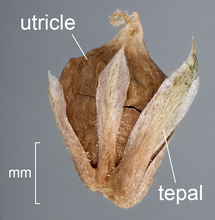 . Pericarppericarp:
. Pericarppericarp:
fruit wall or fruit coat
white, leatheryleathery:
texture—moderately thick, tough, and very pliable
, glabrousglabrous:
without hairs
, smooth. Mesocarpmesocarp:
the middle layer of the pericarp, if divided into layers
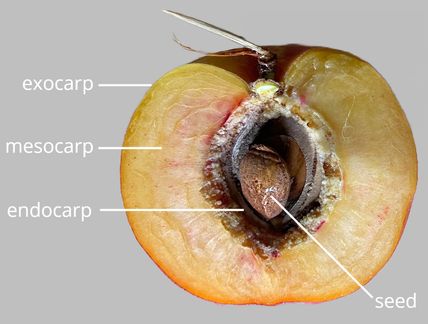 fleshyfleshy:
fleshyfleshy:
texture—fairly firm and dense, juicy or at least moist, and easily cut
.
Seed oblongoblong:
2D shape—much longer than broad with nearly parallel sides, corners are rounded to ellipsoidellipsoid:
to ellipsoidellipsoid:
3D shape—elliptic
, triangulartriangular:
2D shape—three relatively straight sides with distinct corners; more angular than teardrop-shaped in transectiontransection:
in transectiontransection:
a cross section; representing a plane made by cutting across an organ at a right angle to its length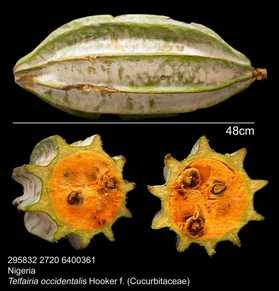 , 1.5–4 mm long. Seed coat light brown without mottling or spotting, smooth and bristlybristly:
, 1.5–4 mm long. Seed coat light brown without mottling or spotting, smooth and bristlybristly:
having bristles or stiff hair or hair-like structures
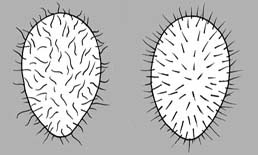 (A. gramineus) or with small pits or depressions (A. calamus).
(A. gramineus) or with small pits or depressions (A. calamus).
Embryo conicalconical:
3D shape—cone-shaped, with the point of attachment at the broad end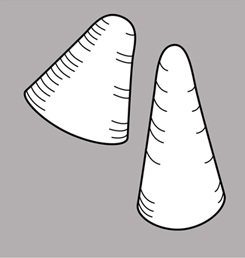 (A. gramineus) or linearlinear:
(A. gramineus) or linearlinear:
(shape) long, narrow, and uniform in width; (of embryo) embryo is straight and much longer than wide
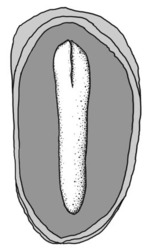 (A. calamus), straight, green. Endospermendosperm:
(A. calamus), straight, green. Endospermendosperm:
nutritive starch- and oil-containing tissue present in many seeds
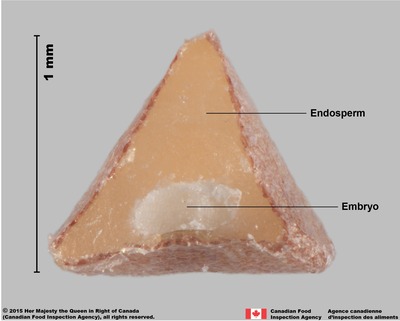 copious; perisperm present. glochidia
copious; perisperm present. glochidia
Weedy in wetlands or along streams with aggressive spreading by rhizome.
| Fruit | |
| Type | berryberry: an indehiscent, fleshy fruit with one or a few to many seeds. The flesh may be homogenous throughout. Or, if the outer part is hard, firm, or leathery, referred to as an hesperidium. Septa are present in some, and the seeds may be arillate or with a fleshy testa.  |
| Size range | 4–6 mm long |
| Shape(s) | oblong, ovoidovoid: 3D shape—ovate  , cuneiformcuneiform: , cuneiformcuneiform:=wedge-shaped , trigonous |
| Texture | epicarp epicarp: outer layer of fruit wall or pericarp, if divided into layers; note here used synonymously with exocarp  - leatheryleathery: - leatheryleathery:texture—moderately thick, tough, and very pliable ; mesocarpmesocarp: the middle layer of the pericarp, if divided into layers  - fleshy - fleshy |
| Surface relief | smooth |
| Color(s) | white or brown |
| Unique features | Small fleshyfleshy: texture—fairly firm and dense, juicy or at least moist, and easily cut berriesberries: an indehiscent, fleshy fruit with one or a few to many seeds. The flesh may be homogenous throughout. Or, if the outer part is hard, firm, or leathery, referred to as an hesperidium. Septa are present in some, and the seeds may be arillate or with a fleshy testa.  with persistent tepalstepals: with persistent tepalstepals:a member of the perianth, when it cannot be differentiated into a calyx and corolla  at maturity. at maturity. |
| Seed | |
| Size range | 1.5–4 mm long |
| Shape(s) | oblong, ellipsoidellipsoid: 3D shape—elliptic , ovoid |
| Surface relief | smooth, pittedpitted: surface relief—surface with small depressions in which the areas between the hollows do not take on the appearance of a true reticular net  , punctate , punctate |
| Color(s) | brown |
| Unique features | Seeds glabrousglabrous: without hairs in A. calamus and bristlybristly: having bristles or stiff hair or hair-like structures  in A. gramineus. in A. gramineus. |
| Other | |
| Embryo | conical conical: 3D shape—cone-shaped, with the point of attachment at the broad end  or linearlinear: or linearlinear:(shape) long, narrow, and uniform in width; (of embryo) embryo is straight and much longer than wide  , straight, green, partially fills seed coat , straight, green, partially fills seed coat |
| Nutritive tissuenutritive tissue: tissue within the seeds that nourishes the developing embryo; such as endosperm, perisperm, or chalazosperm in angiosperms; megagametophyte in gymnosperms |
copious perispermperisperm: seed nutritive tissue comparable to the endosperm, but derived from the nucellus (maternal tissue) and endosperm |
Temperate Northern Hemisphere (North America, Europe, Northern and Central Asia) and tropical Indo-Malaysia.
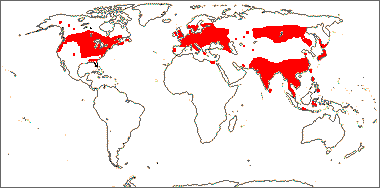
Distribution map courtesy of Angiosperm Phylogeny Website.
Baskin and Baskin 2021Baskin and Baskin 2021:
Baskin C and Baskin J. 2021. Relationship of the lateral embryo (in grasses) to other monocot embryos: A status up-grade. Seed Science Research 31 (3): 199-210. doi:10.1017/S0960258521000209; Bogner 2011Bogner 2011:
Bogner J. 2011. Acoraceae. Flora Malesiana 20: 1ndash;13.; Dahlgren et al. 1985Dahlgren et al. 1985:
Dahlgren RMT, Clifford HT, and Yeo PF. 1985. The families of the monocotyledons: structure, evolution, and taxonomy. Springer-Verlag, Berlin. 520 pp.; Flora of Australia 2021+Flora of Australia 2021+:
Flora of Australia. Australian Biological Resources Study, Canberra. Accessed January-May 2021. URL: http://www.ausflora.org.au; Flora of North America Editorial Committee 1993+Flora of North America Editorial Committee 1993+:
Flora of North America Editorial Committee, eds. 1993+. Flora of North America North of Mexico [Online]. 22+ vols. Flora of North America Association, New York and Oxford. Accessed January-December 2021. URL: http://beta.floranorthamerica.org.; Kirkbride et al. 2006Kirkbride et al. 2006:
Kirkbride JH, Jr, Gunn CR, and Dallwitz MJ. 2006. Family guide for fruits and seeds, vers. 1.0. Accessed September 2020ndash;January 2022. URL: https://nt.ars-grin.gov/seedsfruits/keys/frsdfam/index.cfm .; Kubitzki et al. 1990+Kubitzki et al. 1990+:
Kubitzki K et al., eds. 1990+. The families and genera of vascular plants. 7+ vols. Berlin etc.; Le and Xu 2017Le and Xu 2017:
Le C and Xu Z. 2017. Identication and control of common weeds: Volume 3. Springer Nature, Singapore. 944 pp.; Zhengyi et al. 2004+Zhengyi et al. 2004+:
Zhengyi W, Raven PH, and Deyuan H. 2004+. Flora of China [online]. 25 vols. Science Press, Beijing China amp; Missouri Botanical Garden, St. Louis USA. Accessed January-December 2021. http://flora.huh.harvard.edu/china/
*The number of genera and species is based on Christenhusz and Byng 2016Christenhusz and Byng 2016:
Christenhusz MJM and Byng JW. 2016. The number of known plant species in the world and its annual increase. Phytotaxa 261 (3): 201ndash;217. https://doi.org/10.11646/phytotaxa.261.3.1, which may differ from the number of genera in GRIN-Global.